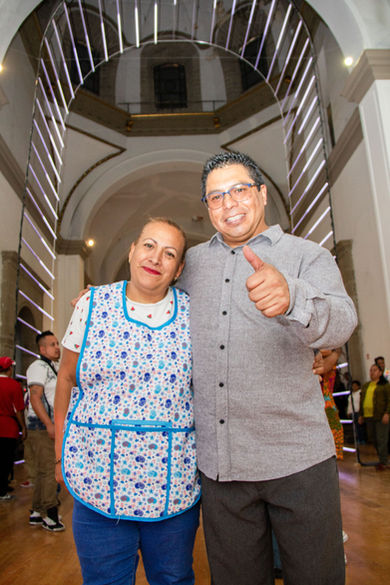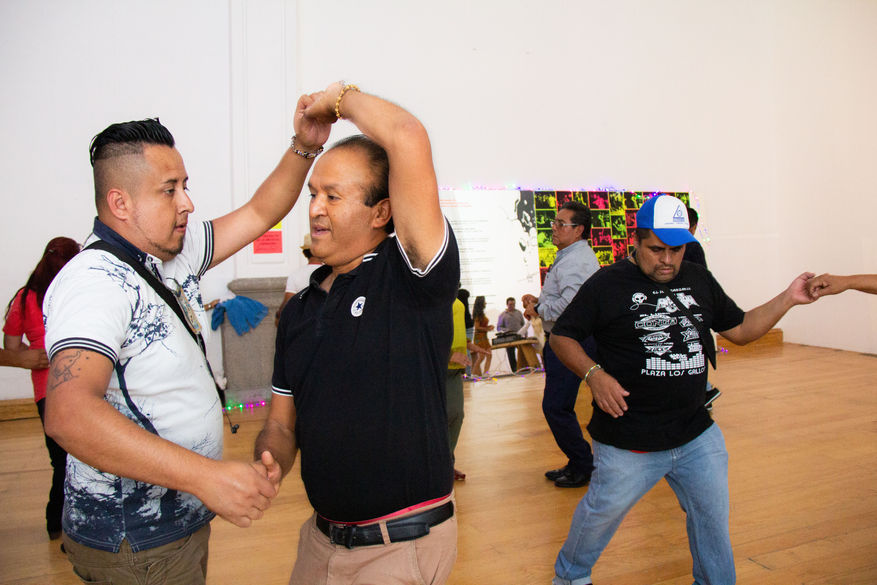A SONIDERO DANCE PROJECT, ITS HISTORY, SOLIDARITY, AND RESILIENCE
El Sonidero de la Güera is a participatory project that merges music, photography, and public space intervention. At its core, the project is a collective creation: a cumbia song inspired by the testimonies of those who attend El Baile de La Güera, a vibrant sonidero event where a DJ curates Latin rhythms for lively street dance gatherings.
For 18 years, El Baile de La Güera cultivated an inclusive and democratic space—one that defied traditional gender roles, resisted gentrification, and fostered deep human connections through dance.
Video about the project
The song serves as a rhythmic tribute, narrating the history of El Baile de La Güera and celebrating its legacy of resilience. Accompanying this musical piece is a black-and-white photographic series that captures the soul of the event—ranging from spirited dance competitions to intimate everyday moments—and the diverse community that keeps it alive.
Photographs of El Baile de la Güera dance, Plaza de la Solidaridad, 2019.
The project included two public activations: one in Plaza de la Solidaridad and another at the Laboratorio de Arte Alameda Museum. At both events, the song opened the dance floor and encouraged audience participation. The photographs were printed, exhibited, and ultimately gifted to the project participants in gratitude for their involvement.
Dance activations of the song El Sonidero de la Güera inside the Laboratorio de Arte Alameda Museum and at the Plaza de la Solidaridad with the participants, Mexico City, 2019
Installation: Báilenme hasta que se cansen
Exhibited at Tianguis: Otr+s, Tod+s, Nosotr+s, Laboratorio de Arte Alameda Museum, Mexico City, Mexico, 2021
This project was developed in 2019. However, after the pandemic, the authorities in Mexico City’s historic center took the opportunity to restructure Plaza de la Solidaridad. They altered the space in a way that made it unsuitable for hosting the beloved dance event. The once-fluid dance floor became uneven due to the addition of new plants, benches, and other urban furnishings—part of a broader gentrification effort aimed at sanitizing the park’s image while disregarding its cultural significance.
As a result, El Baile de La Güera relocated to Alameda Central park. Yet, due to bureaucratic obstacles, permit restrictions, and territorial disputes, the event was ultimately forced to end in 2021.
Though the dance may have ceased, its spirit lives on. The song now stands as a powerful testament to its history and enduring legacy.
This project is part of Tianguis: Otr+s, Tod+s, Nosotr+s, a program hosted by the Laboratorio de Arte Alameda Museum.
El Sonidero de la Güera
(lyrics)
Welcome to the space where we all belong.
La Güera’s dance.
Welcome, everyone.
La Güera started by selling records.
From the Alameda, exactly Alameda, Alameda, and most of us have followed her,
so it’s a familiar place where we’ve seen whole families attend—children, parents, grandparents.
They come, they go, they dance.
It’s something very special because it’s the moment we all step away from whatever we’re doing
and do something we truly enjoy.
We have fun, and above all, we love it.
I love making people happy, the people who come to my dance.
That’s the essence of my dance— to connect with people, to be close to them.
It has made me more human.
I wouldn’t trade this dance for anything.
My life is here. I grew up here.
I became who I am at La Güera’s dance.
CHORUS
This is the dance, the dance, the dance of La Güera.
Come and make it yours, reclaim the people's dance.
Dance this dance, the dance, the dance of La Güera.
Step into the streets, come on, let’s enjoy.
So, so, so, so, solidarity.
Freedom.
Rhythm!
Now it's my turn, here at the Parque de la Solidaridad.
We have been resisting, we have been fighting, because we don’t want to lose this space.
Many people don’t have the means to go to a dance hall or to go out elsewhere.
For them, a public dance is the only form of connection, the only distraction.
Many people come with problems, with depression, and dance is health.
That means this space is necessary.
You can be heterosexual, bisexual, homosexual, trisexual—that’s your business.
You come here to belong, to dance, to have fun, and most of all, to be yourself.
The government should open more spaces.
They’re already boxing us in. Imagine if this is taken away—where will all these people go?
And we must resist. Why do they want to take it from us?
As a woman, you have to fight twice as hard. Women are warriors.
I had to win the battle, and here I am— they haven’t defeated me.
As a woman, I feel much safer in spaces like this than in any dance hall.
Here, everyone is respected. I want this to be a dance of social inclusion.
I want us to be seen with respect in every space. All women have the same rights.
We must not let anyone step on us, especially not men. We must be heard.
We must not be violated by any authority or by any man who wants to put us down.
We fight for our rights, and as a sonidera, I must fight for mine.
I must stand with the people who come to my dance. If this is a fight for all women, we must push forward together.
No to violence against women. Women can. Women are strong.
Long live La Güera’s dance!
CHORUS
This is the dance, the dance, the dance of La Güera.
Come and make it yours, reclaim the people's dance.
Dance this dance, the dance, the dance of La Güera.
Step into the streets, come on, let’s enjoy.
So, so, so, so, solidarity.
Freedom.
Rhythm!
Here, you weave networks. Stories are woven together. I say this is forever, don’t you think?
We met here. We became friends. And here we are, every week.
La Güera has created a kind of family among all of us.
Gifts have been given to people. Food has been shared. Piñatas have been made. This dance has history.
She carries herself with such openness, with a way of treating us that, truly, for me, La Güera is my friend, my sister.
Whatever she needs, she has become a very special person to me.
I feel her love is pure. I feel her friendship.
Sometimes people don’t even want to dance—they just want a hug, a kiss,
to hear someone say, “My love, I care about you,” “My dear, you matter to me.”
She knows how to understand people. She knows how to connect with the people at the dance.
Here, we all see each other as friends, as siblings. We are always united.
I love to dance. She loves to see me, to hug me,
to ask, “How have you been? How’s everything?”
I tell them, “The day I die, dance for me until you can’t dance anymore.”
_____________________________
Presentation(s)
-
Plaza de la Solidaridad, Centro Histórico, Mexico City
-
Laboratorio de Arte Alameda Museum, Mexico City
Year
2019
Participants
Alberto
Alfredo Nava
Ana María F
Erika S
Fanny
Felipe García
Héctor G
Jorge Luis Cruz
La Güera
Mario Vásquez
Nancy A
Ramsés
Raúl Muñoz
Collaborators
Gemma Argüello
Dante Ayala
Credits
Curators
Gemma Argüello
Dante Ayala
Musical Production
Josué Vergara
Photography
Cerrucha
Pablo León Olea
Video Recording
Felipe Huerta
Video Editing
Pablo León Olea
Acknowledgements
Thanks to everyone who participated with their testimonies and for dancing life.






























